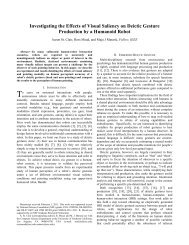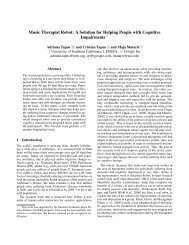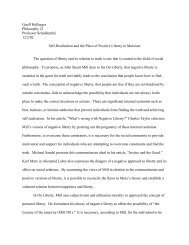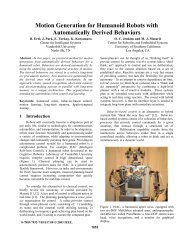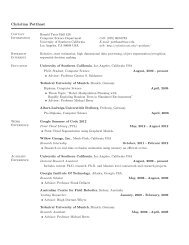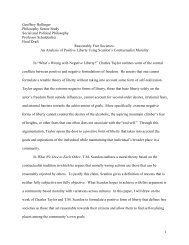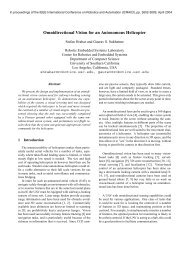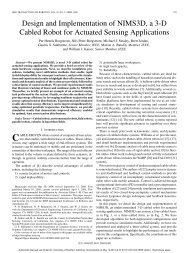A Socially Assistive Robot Exercise Coach for the Elderly
A Socially Assistive Robot Exercise Coach for the Elderly
A Socially Assistive Robot Exercise Coach for the Elderly
Create successful ePaper yourself
Turn your PDF publications into a flip-book with our unique Google optimized e-Paper software.
Fasola & Matarić. A SAR <strong>Exercise</strong> <strong>Coach</strong> <strong>for</strong> <strong>the</strong> <strong>Elderly</strong>Figure 4. Diagram of <strong>the</strong> behavior module’s finite state machine (FSM). The FSMillustrates <strong>the</strong> flow of <strong>the</strong> interaction during <strong>the</strong> exercise sessions. The white arrowemanating from <strong>the</strong> Break Prompt state denotes a user decision.so without sounding repetitive. As discussed earlier, strict repetitiveness, apart frombeing a possible annoyance to <strong>the</strong> user, represents a <strong>for</strong>m of predictability in <strong>the</strong> nature of<strong>the</strong> robot and may negatively affect user engagement in <strong>the</strong> task (Bickmore, Schulman, &Yin, 2010), which could ultimately be detrimental to <strong>the</strong> success of <strong>the</strong> healthcareintervention. We avoid repetitiveness in all comments made by robot, including feedback,praise, empathy, humor, game rules, transitions, and greetings and farewells.We aimed <strong>for</strong> variability in verbal feedback so as to avoid <strong>the</strong> perception ofrepetitiveness as much as possible. When sequential verbal feedback comments differ, asin “Stretch out your right arm” followed by “Now raise your left arm above your head,”<strong>the</strong> variability is inherent. However, when <strong>the</strong> robot needs to report <strong>the</strong> same feedbackcomment in sequence, variability must be introduced into <strong>the</strong> feedback statement itself.We accomplish this variability by introducing filler words. Example filler words include<strong>the</strong> user’s name and <strong>the</strong> words “try” and “just.” Utilizing <strong>the</strong> user’s name not only servesto provide variability, but also works to gain <strong>the</strong> user’s attention, in addition to fur<strong>the</strong>rpersonalizing <strong>the</strong> specific feedback comment. The feedback procedure chooses randomlyat run time whe<strong>the</strong>r to use <strong>the</strong> user’s name, a filler word, or both when repeating aspecific feedback phrase.4. User Study Evaluation with Older AdultsWe designed and conducted a user study with older adult participants to evaluate <strong>the</strong>effectiveness of our SAR approach and system design. Ano<strong>the</strong>r aim of <strong>the</strong> study was toinvestigate <strong>the</strong> role of physical embodiment in <strong>the</strong> robot exercise system. Specifically, <strong>the</strong>study compared <strong>the</strong> effectiveness and participant evaluation of our physical humanoidrobot to those of a computer simulation of <strong>the</strong> same robot shown on a flat-panel display.17



